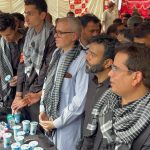Kashmir, with its rich and ancient history, stands as a testament to cultural and religious pluralism. From Kashyap Rishi to Kashyapmer, from Kashyap Sar to Kashmira, from Kashmir to Kashmiri and Koshur, the region’s name and identity have its deep roots in Vedic Sanskriti. The term “Kashmiriyat,” though a recent creation of the 20th century, in the above sequence should also encapsulate a cultural ethos that has evolved over millennia. However, this cultural buzzword has become complex and convoluted, often used and abused by politicians for their ulterior motives, turning it into a national pastime. Kashmiriyat of today is like that one family photo where everyone’s smiling, but nobody’s actually happy. It has turned out to be a cultural cocktail that’s been shaken, stirred, and occasionally served with a side of conflict.
A Historical Crossroads
Kashmir has always been a land at a curious crossroads. To its south lay the rest of Vedic Bharatavarsha; to its west, the land of Gandhara; to its north, the geographically dangerous Pamir knot through which few ventured; and to its east, Tibet. For centuries, Kashmir was a center of Vedic culture, where Shiva and the Sun God Surya were the most revered deities. The land itself gets its name from the ancient sage Kashyap, the progenitor of the gods.
In its ancient past, Kashmir was a melting pot of diverse religious traditions. The earliest among them was Naga or serpent worship. After Naga worship, Buddhism and Saivism emerged almost simultaneously. According to Kalhana, both traditions were present before Ashoka ruled Kashmir in the third century BCE. Vaishnavism entered the land around the sixth century CE, if Kalhana’s account is to be believed. From the late ninth century CE, a new indigenous religious tradition, known as Trika Shaivism or Kashmir Shaivism, began to flourish. Founded by Ācharya Vasugupta (875–925 AD), this tradition was said to have been revealed by Lord Shiva to Acharya Vasugupta. Kashmir Shaivism is a philosophical tradition that views all forms of existence as expressions of the divine essence of ultimate consciousness, promoting a vision of unity and inclusivity.
The Fabric of Kashmiriyat
The early history of these traditions shows a general pattern of initial interactions, leading to brief periods of intellectual confrontation that did not necessarily translate into conflict or hostility. Instead, they evolved into toleration or mutual respect. For instance, the Nilamatapurāna acknowledged Nila Nāga and the Buddha as avatars of Viṣhṇu, despite initial disapproval towards the indigenous cult and Buddhism. This religious tolerance and subsequent engagement had a lasting impact on the social life of the land, shaping the worldview of its people. Thus, the people of ancient Kashmir, despite subscribing to different faiths or ideological strands, coexisted with mutual respect for each other’s beliefs and practices.
This amalgamation of toleration, mutual respect, religious engagements, and exchanges led to the development of a syncretic social attitude, which became an enduring standard of ancient Kashmiris. This cultural milieu produced notable figures like the grammarian Paṇini, the poet Kalidasa, the philosopher Acharya Abhinavagupta, Acharya Khemraj and Yogini Laleshwari, among others. Works like the Kathasaritsagara and texts like the Tantraloka and Pratyabhijna and Lalvakh showcase the intellectual and cultural vibrancy of the region.
The Inclusive Civilization
Kashmiriyat represents an inclusive civilization characterized by pluralism and diversity. These societies value tolerance, open dialogue, and the integration of different cultural, religious, and ethnic groups. Sensitivity to human rights, equality, and social justice are paramount. Inclusive civilizations seek peaceful and negotiated solutions to conflicts, emphasizing reconciliation and coexistence.
If this is the Kashmiriyat we are referring to, then it makes perfect sense. However, something changed?
The Erosion of Kashmiriyat
The narrative of Kashmiriyat began to shift with the advent of external influences and political changes. The region saw periods of intolerance and conflict driven by the imposition of exclusive religious ideologies and political ambitions.
Medieval Tyranny and Forced Conversions
Figures like Sikander Butshikan, also known as the iconoclast, and Shamsuddin Araqi played significant roles in altering the cultural and religious landscape of Kashmir. Sikander Butshikan, known for his brutal campaign against the Kashmiri Hindu population, destroyed thousands of temples and imposed severe measures on the Pandits. It is said that he burnt 2.5 ‘man’ (a unit of weight) of janeu (sacred threads) daily, indicating the mass slaughter of Kashmiri Pandits. The establishment of Bata Mazar, or the graveyard of Kashmiri Pandits in the center of Srinagar, stands as a grim reminder of this dark period.
Shamsuddin Araqi, a religious missionary, was notorious for his forced conversions and destruction of Hindu temples. His biography, Tuhfat-al-Ahbab, boasts of his savagery. Araqi’s mission involved tearing down temples, force-feeding beef, and performing circumcisions to convert the local population to Islam. His followers viewed the non-Muslim Kashmiri community, particularly the Pandits, as the most inflexible in accepting their new faith, leading to violent actions against them.
Mughal and Afghan Rule
The Mughal and Afghan rulers further imposed discriminatory policies, including the jizya (a tax on non-Muslims), prohibiting Pandits from wearing turbans, shoes, or riding horses. These policies aimed to subjugate and suppress the local Hindu population, stripping them of their cultural and religious identity.
Differentiating Rulers and Masses
It is crucial to differentiate between the actions of rulers and the sentiments of the masses. While the rulers were ruthless and sought to destroy the ancient civilization, the masses continued to value diversity and facilitated assimilation. Despite the forced conversions and oppressive measures, the syncretic culture of Kashmir persisted, largely due to the inclusive and adaptable nature of Kashmiri masses as the philosophy of Shaivism had a significant influence over the collective consciousness of masses.
Kashmir Shaivism and Its Influence
The monistic Shaivism of Kashmir had a significant impact on the thought processes of the people, even those who were forcibly converted. Kashmir Shaivism, with its universal, adaptable, flexible, open, and interconnected nature, left an indelible imprint on the mindset of the converts as well. This philosophical tradition emphasized the oneness of all beings and the interconnectedness of all life, fostering an environment of inclusivity and respect.
Even after conversions, many traditional practices continued. For instance, the sacred fish of springs, considered pious and divine by Pandits, were also revered by Muslims, who refrained from eating them. Until recently, some Muslims in Kashmir would create janampatri (Zatuk, astrological charts) for themselves or their family members, a practice rooted in Kashmiri Hindu tradition. Many Muslims also paid `obeisance to certain Hindu gods, temples, and sacred sites.
Examples of this syncretism can be seen in the reverence for the Ragnya Devi temple in Tullamulla, where both Hindus and Muslims would pray and participate in rituals. Similarly, the shrine of Sharika Bhagwati on Hari Parbat was revered by both communities. The preparation of Tehar (the yellow rice) the age old tradition of kashmir, that was made during important rituals continued to be offered by Muslims as well. The annual Urs of various Sufi saints, such as Sheikh Noor-ud-din Noorani (Nund Rishi), Makdoom Sahab also sees participation from people of all faiths, emphasizing the shared spiritual heritage of the region. These shared practices highlight the enduring influence of Kashmir Shaivism and the syncretic culture of the region.
In fact, one question that has always troubled me and remained unanswered is why, despite the immense support Mohammed Ali Jinnah and the Muslim League enjoyed among Muslims in India, they could not penetrate Kashmir to trigger a cycle of Muslim political mobilization. The local Muslim political movement in Kashmir also failed to gain traction despite having a readily available template to follow. Instead of following the mobilization script established by the majority of Muslims on the subcontinent, the general Muslims masses in Kashmir pursued a more secular nationalist ideology. In fact, a nascent Muslim political movement was transformed into a secular nationalist movement, with local leadership elevating the concept of Kashmiri ethnic identity, or Kashmiriyat, to such an extent that the religious aspect of that identity was subdued.
The answer to this lies in the collective consciousness of the masses that had a significant impact through the Kashmir Shaivism philosophy. This inclusivity and respect for diversity influenced the broader population, fostering a unique cultural environment where religious identity was often secondary to a shared Kashmiri identity. The deep-rooted syncretism and the philosophical underpinnings of Kashmir Shaivism played a crucial role in shaping the region’s distinctive path, resisting the divisive mobilization seen elsewhere on the subcontinent.
Questioning the False Narrative
Perhaps a false narrative has been created that after 12th century, the advent of exclusive civilizations in Kashmir, the religious conversion spread not by the sword but by the will of the people. This narrative raises several critical questions:
- If it was free choice that made people accept new religion, why did Sikander Butshikan destroy thousands of temples and kill thousands of Pandits every day?
- What savagery is Shamsuddin Araqi boasting in his biography,”Tuhfat-al-Ahbab”?
- What does the Bata Mazar in the center of Srinagar remind us?
- Why were jizya and other discriminatory taxes levied on non-Muslims?
- What is the story behind seven (7) Exoduses of Kashmiri Pandits?
- Why were Pandits prohibited from wearing turbans, shoes, or riding horses?
- Why are historical names of Kashmir changed to erase its ancient past?
These and many more questions dispel the illusion that the new religion after the 12th century was accepted out of sweet will. Historical evidence points to a coercive and violent conversion process that aimed to subjugate the local Kashmiri Pandit population and erase their cultural and religious identity.
Additionally, some superficial conversions likely occurred as a means of escaping execution. Under the threat of death or heavy taxation, such as the jizya tax imposed on non-Muslims, many Hindus might have temporarily converted to Islam to ensure their survival. These forced conversions were not limited to the era of Sikander Butshikan. The Mughal ruler Aurangzeb, for instance, reintroduced the jizya tax and imposed numerous discriminatory laws on non-Muslims, furthering the agenda of religious subjugation.
Given the existential necessity, temporary conversions cannot be ruled out through certain apparatuses that created a delusion of a softer order. For instance, while some individuals might have outwardly accepted new religion to avoid persecution, they continued to practice their traditional customs in private. This duality allowed them to navigate the oppressive environment while maintaining a connection to their ancestral faith.
However, these superficial conversions should not be highlighted as a cover to portray the new religion as inherently gentle or benevolent. The coercive methods used to enforce these conversions, including threats, violence, and heavy taxation, paint a starkly different picture. The historical narrative must acknowledge the reality of these forced conversions and the impact they had on the cultural and religious landscape of Kashmir. The resilience of the Kashmiri Hindu community, despite these adversities, is a testament to their enduring spirit and commitment to preserving their heritage.
The Modern Manipulation of Kashmiriyat
In the 20th century, Kashmiriyat as a word became a subversive coinage, used by local politicians to camouflage their divisive politics and vested interests. This manipulation created a deception, masking the historical grievances and cultural suppression that had plagued the region. Politicians have misused Kashmiriyat to create a cultural amnesia, where historical experiences of oppression and forced assimilation are forgotten or minimized in the collective memory. They presented a façade of inclusivity and tolerance while ignoring the historical grievances and cultural suppression.
Distortion of History
The distortion of historical names and places further eroded the cultural identity of Kashmir. Historical names like Shankracharya became Takhtesulemani, Hariparbat became Koh-i-Maran, Anantnag became Islamabad, and Padampora became Pampore, Varhamulla becoming Baramulla, or Gaurimarg becoming Gulmarg, Vijeshwara became Bijbehara, Bandhapura becomes Bandipura, recently the cave of Acharya Abhinavgupta was found in beerva, called Bairav Cave, however on papers, as reported, someone played mischief and wrote Bairam Cave.
These changes aimed to erase the region’s rich ancient past and impose a new cultural narrative.
The Death of Kashmiriyat
Kashmir, once a beacon of inclusive civilization, has tragically been pushed to become an exclusive and intolerant society where the saner voices have been trampled and insaner voices amplified. The original ideals of Kashmiriyat—rooted in pluralism, diversity, and mutual respect—have been overshadowed by a mere façade of inclusivity and tolerance.
Religious extremism has strengthened itself by propagating the narrative that atrocities, such as the genocide of their people, have been and continue to be carried out by other religions. For the proponents of extremist ideologies, the concept of Kashmiriyat is not just irrelevant but also contrary to the notion of their religious brotherhood. The influence of Wahhabi ideology has distorted the meaning of Kashmiriyat. Salafism, in particular, has radicalized the youth, eroding the spirit of Kashmiriyat. These ideologies mandate the conversion of Kashmir into a mono-religious region, aiming to expel all others from the valley.
The militant and extremist struggle shifted its focus from being a fight for Kashmir’s independence to a fight for establishing a religious fundamentalist theocratic state. The silent support among a significant portion of the valley’s population for this ideology has created a pervasive atmosphere of fear among the Kashmiri Pandit community, severely damaging inter-community relations.
The mass exodus of the Kashmiri Pandits, coupled with the spread of a more orthodox religious ideology, caused the majority of people in Kashmir to drift away from the principles of Kashmiriyat. They ceased to value the idea of coexistence and secularism. This fundamentalist doctrine has penetrated deeply into the psyche of local communities, widening the gap between Hindus and Muslims in the valley, and delivering a fatal blow to Kashmiriyat.
The state’s promotion of the idea of Kashmiriyat predominantly among the Muslim population, rather than equally among the Pandit and other non muslim community, during the exodus of the Kashmiri Pandits, exacerbated the situation. The state’s failure to maintain a balanced narrative contributed to the erosion of Kashmiriyat, as the concept became more associated with one community over the other.The imposition of homogeneity and suppression of diverse identities has further led to the loss of the region’s rich cultural heritage. Political misuse of Kashmiriyat has contributed to a superstructure of words that ignored historical grievances, promoting a false narrative of unity.
The ideals of Kashmiriyat have been undermined by religious extremism, radical ideologies, and the socio-political turmoil that followed. The cultural and religious diversity that once defined Kashmir has been overshadowed by a fundamentalist vision, resulting in the tragic death of Kashmiriyat.
Conclusion
Kashmiriyat, once a beacon of hope for an inclusive and pluralistic society, has been murdered by political manipulation and cultural hegemony. The term, which once symbolized the rich cultural heritage of Kashmir, now serves as a reminder of what was lost. The hope for a society that embraces diversity and mutual respect remains a distant dream, overshadowed by a history of conflict and suppression.
It is a call to reclaim the inclusive spirit that once defined the region and to resist the forces that seek to manipulate and distort its rich heritage. Kashmiriyat’s true potential lies in its original ideals of pluralism, tolerance, and mutual respect, which need to be revived and celebrated for the hope they once promised. The intercommunity dialogue is the need of the hour; besides the government’s role, the civil society has to come forward and rekindle the spirit of the true value and meaning of Kashmiriyat.
To revive Kashmir’s glory, we must embrace Kashmiriyat; a timeless philosophy of unity and respect that can heal past wounds, mend divisions, and guide us towards a future where all communities work together in harmony and prosperity and lead Kashmir towards a path of peace, where every community works together for a common good.
(The Author is Vice Chancellor: Shri Vishwakarma Skill University)








